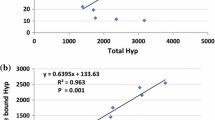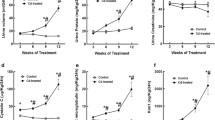Abstract
In order to investigate the effect of cadmium-metallothionein (Cd-MT) on renal reabsorption of collagen metabolites, urinary excretion of hydroxylysine (Hyl), glucosyl-galactosyl-Hyl (Glc-Gal-Hyl), galactosyl-Hyl (Gal-Hyl), and hydroxyproline (Hyp), which are unique collagen metabolites, was determined in rats. Administration of Cd-MT resulted in acute renal failure in the form of proteinuria, aminoaciduria and glycosuria. Protein content in urine was greatly increased 1 day after injection of Cd-MT and decreased from 5 days, while the maximum levels of excretion of amino acids and glucose were observed at 6 days post-injection. The urinary excretion of total Hyp and Hyl, including Glc-Gal-Hyl, Gal-Hyl and free Hyl, were significantly increased at 3, 6 and 8 days after injection of Cd-MT with the maximum level at 6 days. Moreover, the molar ratio of Glc-Gal-Hyl/Gal-Hyl of urine in the Cd-MT-treated group was almost the same as that in the controls. These results suggest that a portion of Hyp, Hyl and its glycosides is normally reabsorbed from the renal tubule in the controls, and Cd-MT exposure caused an increase in urinary excretions of Hyp and Hyl, including its glycosides, through a renal tubular defect in reabsorption of Hyl in the same manner as with common amino acids.
Similar content being viewed by others
References
Cherian MG, Goyer RA, Richardson LD (1976) Cadmium metallothionein-induced nephropathy. Toxicol Appl Pharmacol 38: 399–408
Iguchi H, Sano H (1982) Effect of cadmium on the bone collagen metabolism of rat. Toxicol Appl Pharmacol 62: 126–136
Kimura M (1981) Effect of cadmium on growth and bone metabolism. In: Nriagu JO (ed) Cadmium in the environment. John Wiley & Sons, New York, pp 757–782
Lucis O, Link ME, Lucis R (1968) Turnover of cadmium 109 in rats. Arch Environ Health 18: 307–310
Nagai Y, Sato M, Sasaki M (1982) Effect of cadmium administration upon urinary excretion of hydroxylysine and hydroxyproline in the rat. Toxicol Appl Pharmacol 63: 188–193
Nagai Y, Sato M, Sasaki M, Tsurumi K, Kimura A, Koseki M, Seino H (1986) Urinary excretion of hydroxylysine in pulmunary fibrosis, Itai-itai disease and scleroderma. Fukushima J Med 36: 226–232
Nomiyama K, Sugata Y, Yamamoto A, Nomiyama H (1975) Effect of dietary cadmium on rabbit. 1. Early signs of cadmium intoxication. Toxicol Appl Pharmacol 31: 4–12
Nordberg GF (1979) Renal effects of mercury- and cadmium-metallothionein. In: Kägi JHR, Nordberg M (eds) Metallothionein. Birkhäuser Verlag, Basel/Boston, pp 347–350
Nordberg GF, Goyer RA, Nordberg M (1975) Comparative toxicity of cadmium-metallothionein and cadmium chloride on mouse kidney. Arch Pathol 99: 192–197
Prockop DJ, Kivirikko KI (1968) In: Gould BS (ed) Hydroxyproline and metabolism of collagen. Treatise of collagen. Academic Press, London 2(A), pp 215–245
Reiser KM, Last JA (1986) Biosynthesis of collagen cross links: in vivo labelling of neonatal skin, tendon, and bone in rats. Connect Tissue Res 14: 293–306
Satake K, Okayama T, Ohashi M, Shinoda T (1960) The spectrophotometric determination of amine, amino acid and peptide with 2, 4, 6-trinitrobenzene 1- sulfonic acid. J Biochem 47: 654–660
Sato M, Nagai Y (1986) Cadmium in rat kidney subcellular particles after injection of cadmium-metallothionein. J Toxicol Sci 11: 29–39
Segrest JP (1982) Urinary metabolites of collagen. Method Enzymol 82: 398–410
Smith R, Elia M (1981) The significance of urinary hydroxyproline and 3-methylhistidine changes in growth, starvation and injury. In: Rattenbury JM (ed) Amino acid analysis. Ellis Horwood Ltd., Chichester, England, pp 225–236
Squibb KS, Pritchard JB, Fowler BA (1984) Cadmium-metallothionein nephropathy: Relationships between ultrastructural/biochemical alterations and intracellular cadmium binding. J Pharmacol Exp Ther: 229: 311–321
Suzuki KT, Maitani T, Takenaka S (1979) Fate of intraperitoneally injected liver metallothionein in rat kidney. Chem Pharm Bull 27: 649–653
Yamamoto A, Nomiyama K, Sugata Y (1972) A modified method for the determination of urinary amino acids with sodium 2-, 4-, 6-trinitrobenzene sulfonate (TNBS). In Proceedings of the 45th Jap Assoc Ind Health, pp 348–349
Author information
Authors and Affiliations
Rights and permissions
About this article
Cite this article
Sato, M., Sasaki, M. & Nagai, Y. Increased urinary excretion of collagen metabolites in cadmium-metallothionein nephropathy. Arch Toxicol 61, 116–119 (1987). https://doi.org/10.1007/BF00661368
Received:
Accepted:
Issue Date:
DOI: https://doi.org/10.1007/BF00661368




